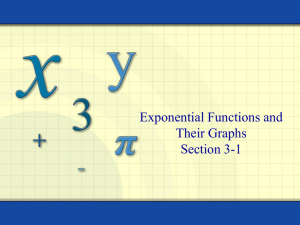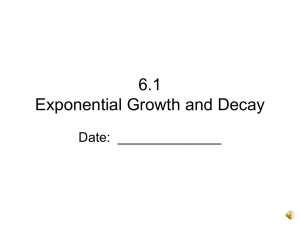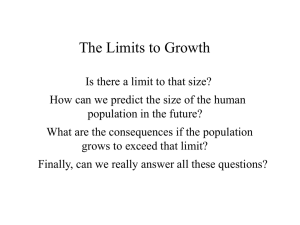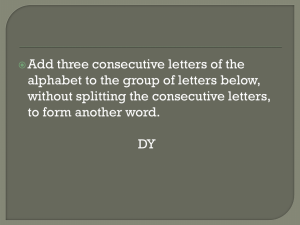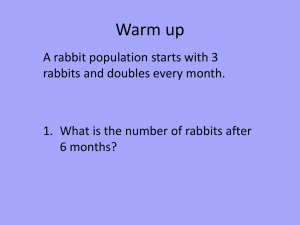Linear vs. Exponential Word Problems
advertisement
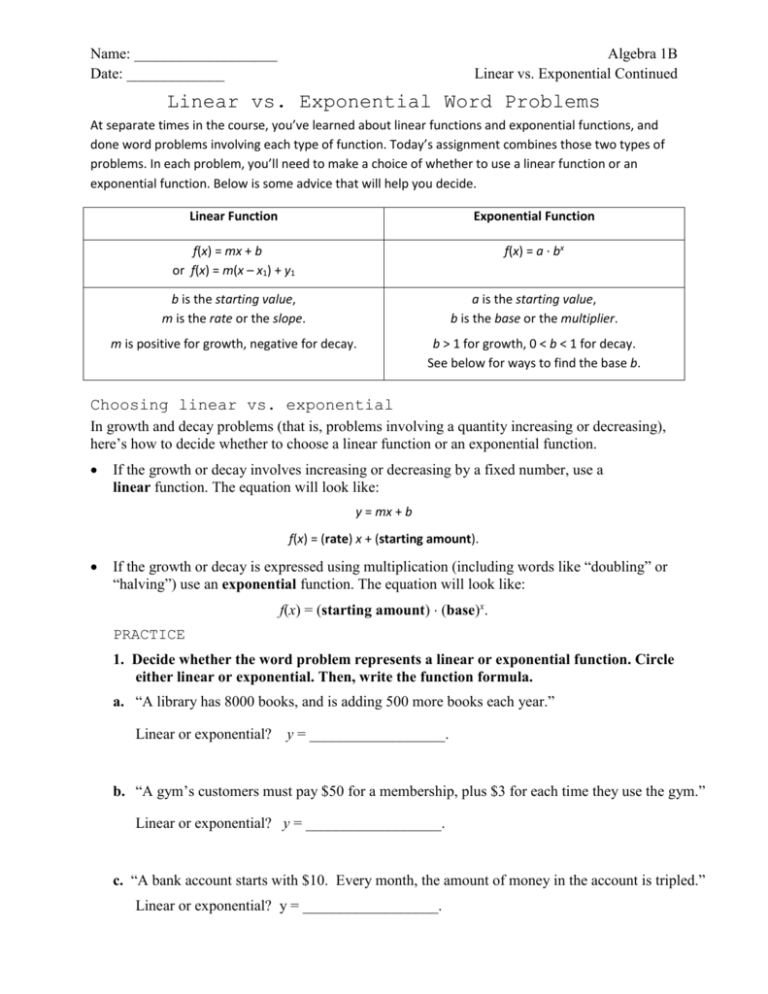
Name: ___________________ Date: _____________ Algebra 1B Linear vs. Exponential Continued Linear vs. Exponential Word Problems At separate times in the course, you’ve learned about linear functions and exponential functions, and done word problems involving each type of function. Today’s assignment combines those two types of problems. In each problem, you’ll need to make a choice of whether to use a linear function or an exponential function. Below is some advice that will help you decide. Linear Function Exponential Function f(x) = mx + b or f(x) = m(x – x1) + y1 f(x) = a · bx b is the starting value, m is the rate or the slope. a is the starting value, b is the base or the multiplier. m is positive for growth, negative for decay. b > 1 for growth, 0 < b < 1 for decay. See below for ways to find the base b. Choosing linear vs. exponential In growth and decay problems (that is, problems involving a quantity increasing or decreasing), here’s how to decide whether to choose a linear function or an exponential function. If the growth or decay involves increasing or decreasing by a fixed number, use a linear function. The equation will look like: y = mx + b f(x) = (rate) x + (starting amount). If the growth or decay is expressed using multiplication (including words like “doubling” or “halving”) use an exponential function. The equation will look like: f(x) = (starting amount) (base)x. PRACTICE 1. Decide whether the word problem represents a linear or exponential function. Circle either linear or exponential. Then, write the function formula. a. “A library has 8000 books, and is adding 500 more books each year.” Linear or exponential? y = __________________. b. “A gym’s customers must pay $50 for a membership, plus $3 for each time they use the gym.” Linear or exponential? y = __________________. c. “A bank account starts with $10. Every month, the amount of money in the account is tripled.” Linear or exponential? y = __________________. Name: ___________________ Date: _____________ Algebra 1B Linear vs. Exponential Continued d. “At the start of a carnival, you have 50 ride tickets. Each time you ride the roller coaster, you have to pay 6 tickets.” Linear or exponential? y = __________________. e. “There are 20,000 owls in the wild. Every decade, the number of owls is halved.” Linear or exponential? y = _________________. 2. Decide whether the table represents a linear or exponential function. Circle either linear or exponential. Then, write the function formula. a. x y 0 2 1 5 2 8 3 11 4 14 5 17 6 20 7 23 6 192 7 384 6 .15625 7 .078125 6 -12 7 -16 Linear or exponential? y = __________________. b. x y 0 3 1 6 2 12 3 24 4 48 5 96 Linear or exponential? y = __________________. c. x y 0 10 1 5 2 2.5 3 1.25 4 .625 5 .3125 Linear or exponential? y = __________________. d. x y 0 12 1 8 2 4 3 0 4 -4 5 -8 Linear or exponential? y = __________________ e. x y 0 50 1 35 Linear or exponential? 2 24.5 3 17.15 4 12.005 5 8.4035 y = __________________ 6 5.88245 7 4.117715 Name: ___________________ Date: _____________ Algebra 1B Linear vs. Exponential Continued f. x y 0 40 1 35 2 30 3 25 4 20 5 15 6 10 5 3.0375 6 4.55625 7 5 Linear or exponential? y = __________________ g. x y 0 .4 1 .6 2 .9 3 1.35 4 2.025 7 6.834375 Linear or exponential? y = __________________ 3. Without a calculator, make a table for f(x) = x f(x) = 1 x 8. 2 1 x8 2 0 1 2 3 4 5 6 4. Without a calculator, make a table for f(x) = 8 ( 12 ) x . Express answers as fractions. x f(x) = 8 ( 12 ) x in fractions 0 1 2 3 4 5 6 Name: ___________________ Date: _____________ Algebra 1B Linear vs. Exponential Continued 5. A science experiment involves periodically measuring the number of mold cells present on a piece of bread. At the start of the experiment, there are 50 mold cells. Each time a periodic observation is made, the number of mold cells triples. For example, at observation #1, there are 150 mold cells. a. Write a function formula equation (y = ···) for the number of mold cells present, where x stands for the observation number. b. Fill in the missing outputs of this table. x = observation number 0 1 y = mold cell count 50 150 2 3 4 c. Suppose that the mold begins to be visible as green coloration when the mold cell count exceeds 100,000. On which observation will this happen? d. What will be the mold cell count on the 20th observation? When you find the answer on your calculator, it will be so large that it displays in scientific notation (E notation). Rewrite the answer as an ordinary big number. 6. Julie gets a pre-paid cell phone. Initially she has a $40.00 balance on the phone. Each minute of talking costs $0.15. Let x stand for the amount of time in minutes that Julie has talked on the phone, and let f(x) stand for the remaining dollar value of the phone. a. Is f(x) a linear function or an exponential function? Explain how you know. b. Find a function formula equation f(x) = ______________________ c. Find the value of f(0) and explain its meaning in terms of the cell phone. d. Find the value of f(100) and explain its meaning in terms of the cell phone. 5 Name: ___________________ Date: _____________ Algebra 1B Linear vs. Exponential Continued e. Find the value of x that makes f(x) = 10, and explain its meaning in terms of the cell phone. f. Find the value of x that makes f(x) = 0, and explain its meaning in terms of the cell phone. 7. Sketch a graph of the function y 3 2 x on the axes below. Be sure to label the y-intercept. Hint: the y-intercept is the starting amount x 8. Sketch a graph of the function y 5 3 on the axes below. 4 Be sure to label the y-intercept. x 5 9. Sketch a graph of the function y on the axes below. 2 Be sure to label the y-intercept.


